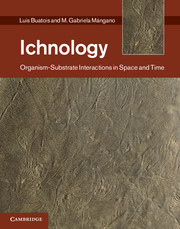Book contents
- Frontmatter
- Contents
- Acknowledgments
- Introduction
- Part I Conceptual tools and methods
- Part II Spatial trends
- 6 Trace fossils and paleoecology
- 7 Ichnology of shallow-marine clastic environments
- 8 Ichnology of marginal-marine environments
- 9 Ichnology of deep-marine clastic environments
- 10 Ichnology of continental environments
- 11 Ichnology of carbonate environments, rocky shorelines, and volcanic terrains
- Part III A matter of time
- References
- Index
8 - Ichnology of marginal-marine environments
from Part II - Spatial trends
Published online by Cambridge University Press: 25 October 2011
- Frontmatter
- Contents
- Acknowledgments
- Introduction
- Part I Conceptual tools and methods
- Part II Spatial trends
- 6 Trace fossils and paleoecology
- 7 Ichnology of shallow-marine clastic environments
- 8 Ichnology of marginal-marine environments
- 9 Ichnology of deep-marine clastic environments
- 10 Ichnology of continental environments
- 11 Ichnology of carbonate environments, rocky shorelines, and volcanic terrains
- Part III A matter of time
- References
- Index
Summary
“Is there any other point to which you would wish to draw my attention?”
“To the curious incident of the dog in the night-time.”
“The dog did nothing in the night-time.”
“That was the curious incident,” remarked Sherlock Holmes.
Sir Arthur Conan Doyle “Silver Blaze” (1892)Marginal-marine environments represent one of the most successful areas of ichnological research. These environments comprise a wide variety of coastal settings characterized by rapid environmental perturbations, typically salinity changes, but also increased sediment discharge and extreme clay flocculation, among many other controls. These different factors generate stressful conditions that strongly affect benthic biotas, imparting clearly detectable signals in the ichnological record (e.g. Pemberton and Wightman, 1992; MacEachern and Pemberton, 1994; Buatois et al., 1997b; Mángano and Buatois, 2004a; MacEachern and Gingras, 2007). Ichnology is a powerful tool to differentiate deposits formed under marginal-marine conditions from those that accumulated in fully marine settings. In this chapter we review the ichnology of different marginal-marine environments, visiting estuaries, bays, deltas, and fjords.
- Type
- Chapter
- Information
- IchnologyOrganism-Substrate Interactions in Space and Time, pp. 152 - 180Publisher: Cambridge University PressPrint publication year: 2011

